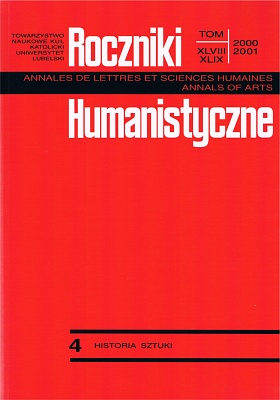Galeria pod Moną Lizą. Historia i ideologia
Abstrakt
The text The Mona Lisa Gallery – its history and ideology is an attempt at looking at the Polish avant-garde art of the 1960s from the point of view of the institution presenting it – an author's gallery. In The Mona Lisa Gallery managed by Jerzy Ludwiński twenty exhibitions were shown that well illustrate the direction of changes in Polish art of the decade. In that period we encountered a particular crisis of the autonomous and integral structure of the work of art. At the same time there was an increasing activity of artistic circles during group performances at plein-air painting sessions, artistic symposiums and when organising independent author's galleries. These galleries, among them being The Mona Lisa Gallery, took on a special role: they both witnessed the disintegration of the work of art and stimulated the process of breaking up the traditionally understood work. Exposing such an uncertain status of it was presumed by Ludwiński in the text about the Gallery's programme. He planned exhibitions of works that exceeded what their authors had created before. He also obliged them to enter a discussion with the public in the Gallery as well as to publish self-commenting texts in The Odra monthly. Parallel to an article of the given artist a text was to be printed by the critic who had invited him to the Gallery.
The next exhibitions were a consistent attempt at a new definition broadening the scope of the concept of “work of art” against the ever more reduced artistic form. The first three exhibitions of works by Zdzisław Jurkiewicz, Wanda Gołkowska and Henryk Stażewski illustrated, in Ludwiński's opinion, a tendency to leave the closed, autonomous structure of the painting towards stressing the creative process and the artistic conception. The subsequent presentations of works by Jerzy Rosołowicz, Jan Chwałczyk and Stanisław Dróżdż were defined by an attitude of posing the problem of the status of a real phenomenon or object in the space of the Gallery. On the other hand, Włodzimierz Borowski's and Feliks Szyszko's actions were to shake the traditional relations between the artist, work of art and recipient.
In the face of these changes in the art of the 1960s Ludwiński in his article Sztuka w epoce postartystycznej (Art in the post-artistic epoch) postulated introduction of the term “impossible art” to define the form of activity eliminating the borderline between the artistic fact and reality. The institution that would stimulate development of this “post-artistic activity” was supposed to be Centrum Badań Artystycznych (The Centre for Artistic Studies) that formulated its programme during Sympozjum Plastyczne Wrocław '70 (Visual Symposium Wrocław '70). With its developed structure it was to exceed the limitations of the exhibition centres that had existed until then. The Centre was to co-ordinate the movement of artistic ideas, their permeation and exchange among various artistic circles.
The decade of the 1960s was characterised by a particular tension between the work of art and the artistic institution. The “minimalist” reduction of the form was conducted in the well-recognised context of the exhibition space. In the 1970s the artistic institution was subjected to a peculiar “autonomisation”. Apart from the work of art it developed the idea of a “network” in which it distributed utopian project of incessant development of art. However, the plan concerning the Centre was not put into effect. It remained a witness to the period of the turn of the 1960s when there was the intention to situate the concept of work of art outside the gallery walls.
Copyright (c) 2001 Roczniki Humanistyczne

Utwór dostępny jest na licencji Creative Commons Uznanie autorstwa – Użycie niekomercyjne – Bez utworów zależnych 4.0 Międzynarodowe.





